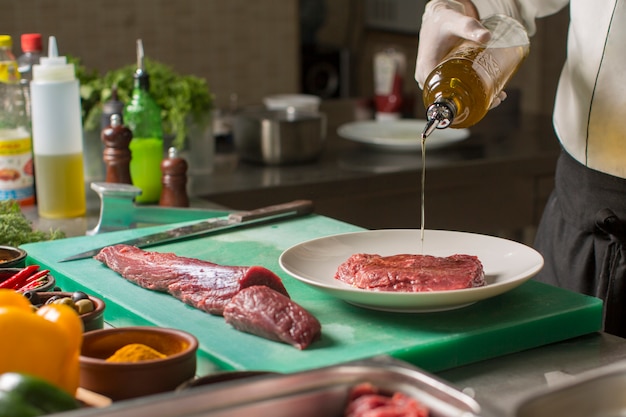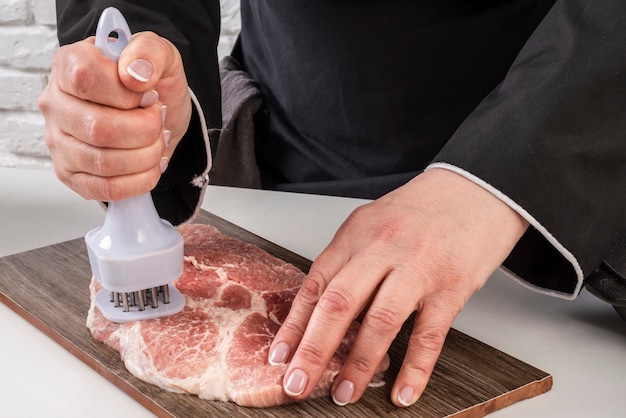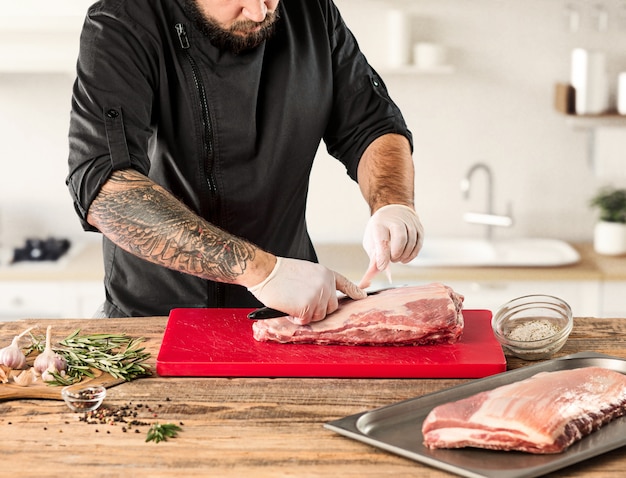Let's face it, there's something about a tomahawk steak that screams "special occasion." It's not just a steak; it's an experience. That long, dramatic bone, the thick, juicy cut of meat – it's a carnivore's dream come true. But cooking a tomahawk steak isn't a walk in the park. It's a performance, a culinary dance that requires confidence, knowledge, and a dash of showmanship. This ultimate guide will walk you through every step, from choosing the perfect cut to achieving that perfect sear and juicy, pink centre. So grab a pen, a glass of something refreshing, and let's get started.
(Part 1) Choosing Your Weapon

The first step in your tomahawk journey is choosing the right piece of meat. This isn't just about grabbing any old ribeye; you're looking for a showstopper, a statement piece that will wow your guests.
The Cut: A Matter of Choice
First things first, let's talk about the cut itself. The most common tomahawk steak is a long bone ribeye or strip steak. These cuts are known for their rich flavour and beautiful marbling, which helps create a juicy, tender steak. You can often find them pre-fashioned into a tomahawk at your butcher shop, but if you're feeling adventurous, you can even ask them to fashion one from a bone-in ribeye for a truly personalized experience.
The Grade: A Taste of Quality
Next comes the grade, which speaks volumes about the quality of the meat. You'll see options like Prime, Choice, and Select, with Prime being the highest grade. This means more marbling, that beautiful intramuscular fat that melts during cooking, infusing the steak with incredible flavour and tenderness. For a tomahawk, you want to go for Prime if you want the ultimate taste experience. It's a bit more expensive, but trust me, it's worth it.
Thickness: The Key to a Perfect Cook
Thickness is another critical factor. You want a steak that's at least 1.5 inches thick, preferably closer to 2 inches. This thickness allows for a beautiful, even sear on the outside while maintaining a juicy, pink center.
The Bone: The Crown Jewel
And, of course, we can't forget the bone. It's the star of the show! Look for a thick, sturdy bone that's not too dry. This bone will add flavor as it roasts and gives you a secure handle for flipping the steak.
(Part 2) Prep Like a Pro

Now that you've found your perfect tomahawk, it's time to get it ready for the big performance. This is where you transform the raw cut into a culinary masterpiece.
Pat it Dry: The Foundation of a Great Sear
Start by patting the steak dry with paper towels. You want a dry surface for a beautiful, even sear. Think of it as giving your steak a mini-spa treatment before it hits the heat.
Seasoning Game On: A Symphony of Flavors
Now, for the seasoning. This is where you can really unleash your creativity, but remember, less is more. A simple blend of kosher salt and freshly ground black pepper is often all you need to let the steak's natural flavors shine. A light sprinkle of smoked paprika or garlic powder can add subtle depth without overpowering the inherent taste of the meat. The key is to enhance, not mask, the natural flavors.
Resting is Key: A Moment of Relaxation
Finally, let the steak rest. You want it to come up to room temperature before you cook it. This helps ensure even cooking and a more tender final product. Thirty minutes to an hour is ideal, giving the steak time to relax and prepare for its grand entrance.
(Part 3) The Big Reveal: Cooking Your Tomahawk

Alright, the moment you've been waiting for: it's time to cook that magnificent tomahawk! You can choose from various cooking methods, but I prefer the trusty, old-school grill method for that signature smoky flavour and char.
The Grill Master: A Hot Seat for a Hot Steak
For the grill, you want it nice and hot, around 450-500 degrees Fahrenheit. Preheat for at least 15 minutes to get those grates screaming hot. This intense heat creates a beautiful sear on the outside while keeping the inside juicy.
The Sear: Creating a Crusty Canvas
Now, it's showtime. Place the tomahawk directly on the grill and sear for 2-3 minutes per side. You want a nice, dark crust that's a testament to the intense heat. Don't be afraid to let it char a little, adding a hint of smoky flavor.
Medium-Rare is the Way to Go: A Culinary Sweet Spot
For a medium-rare steak, which is my personal preference, you're aiming for an internal temperature of around 130-135 degrees Fahrenheit. Use a meat thermometer to get an accurate reading, but you can also test it by pressing on the steak. A firm, springy texture indicates it's close to being done. If you're new to cooking steak, a thermometer is your best bet to avoid overcooking.
Flip It Like It's Hot: Maintaining Even Cooking
Once you've achieved a beautiful sear, flip and repeat the process, rotating the steak to ensure even cooking on all sides. Continue flipping every 2-3 minutes, allowing the heat to penetrate the steak evenly.
Finishing Touches: Subtle Temperature Control
As the steak approaches its desired doneness, move it to a cooler part of the grill to finish cooking. This prevents overcooking and allows for a more gradual increase in temperature, ensuring a perfectly cooked steak.
(Part 4) Resting Like a Champion
You've cooked your tomahawk to perfection, but the journey isn't over yet. It's time for a little rest, a crucial step that ensures the juices redistribute and create a tender, flavourful steak.
The Importance of Resting: Releasing the Juices
Resting is vital for allowing the juices to reabsorb throughout the steak. Think of it as a chance for the steak to recover from the heat, ensuring a delicious and juicy experience.
The Time: A Moment of Patience
Let your tomahawk rest for at least 10 minutes, covered with foil, before slicing. This allows the juices to settle and creates a more tender, flavourful steak. Resist the urge to cut into it right away; a little patience will be rewarded with a truly exceptional eating experience.
(Part 5) Slicing and Serving: The Grand Finale
Alright, the resting is done, and your tomahawk is ready for its grand unveiling. It's time to slice and serve this culinary masterpiece.
Slicing Tips: Unleashing the Flavors
You can slice your tomahawk in a few ways, but I prefer to cut it across the grain. This means slicing perpendicular to the muscle fibres, which makes the meat more tender and easier to chew. Use a sharp knife to ensure clean, precise cuts.
Serving Suggestions: A Feast for the Senses
Serve your tomahawk steak with a side of your choice. Roasted vegetables, a creamy mashed potato, a crisp salad, or a hearty pasta dish are all excellent options. Don't forget a good sauce, like a simple béarnaise or a rich chimichurri, to add another layer of flavor and complexity to your meal.
(Part 6) Beyond the Basics: Playing with Flavour
We've covered the fundamentals of cooking a tomahawk steak, but now let's get creative. There are countless ways to add your own personal touch and elevate this culinary masterpiece to new heights.
Marinade Madness: Infusing Flavor Before Cooking
One way to add depth of flavor is to marinate the steak. Use a simple marinade of olive oil, garlic, herbs like rosemary or thyme, and lemon juice. Or get more adventurous with a chimichurri marinade for a vibrant, herbaceous flavor or a balsamic marinade for a sweet, tangy complexity. The key is to marinate for at least 2 hours, preferably overnight, allowing the flavors to penetrate the meat fully.
Herb Rubs: A Fragrant Embrace
Another great option is to use an herb rub. Combine your favorite herbs, like rosemary, thyme, oregano, and a touch of garlic powder, with a bit of salt and pepper. Rub it generously over the steak before grilling, creating a fragrant crust that adds incredible flavor.
Smoked Flavour: A Touch of Woodsy Magic
If you're feeling adventurous, try smoking your tomahawk steak. Use a wood smoker and your favourite wood chips, like hickory, mesquite, or applewood. The smoky flavour will add a whole new dimension to your steak, creating a truly unique taste experience.
(Part 7) Beyond the Grill: Other Cooking Methods
While the grill is a classic choice, you don't have to limit yourself. There are other fantastic methods to cook a tomahawk steak, each offering its own unique advantages.
The oven method: A Hands-Off Approach
For a more hands-off approach, roast your tomahawk in the oven. Preheat the oven to 400 degrees Fahrenheit and place the steak on a baking sheet. Roast for about 15-20 minutes per side, depending on the thickness of the steak. This method is perfect for those who prefer a little less hands-on cooking but still want a delicious, well-cooked steak.
The Cast Iron Method: Searing with Simplicity
Another excellent option is a cast iron pan. Heat the pan over high heat and sear the steak for 2-3 minutes per side. Then, transfer the pan to a preheated oven (400 degrees Fahrenheit) and cook for another 10-15 minutes. This method provides a beautiful sear and a perfectly cooked interior, making it a fantastic alternative to grilling.
The sous vide method: Precision Cooking for the perfect steak
If you're looking for the most precise and consistent cooking method, try sous vide. This technique involves cooking the steak in a water bath, ensuring a perfectly even cook. Set the water bath to 130-135 degrees Fahrenheit for a medium-rare steak. Cook for 1-2 hours, then sear the steak for a minute or two on each side in a hot pan for a delicious crust. Sous vide offers exceptional control over the cooking process, resulting in a consistently tender and perfectly cooked steak.
(Part 8) Tomahawk steak faqs
Let's address those burning questions that often pop up when tackling a tomahawk steak.
1. How Much Steak Do I Need Per Person?
A good rule of thumb is to allow about 1 pound of tomahawk steak per person. Remember, that bone is going to add a good chunk of weight, so plan accordingly.
2. Can I Cook a Tomahawk Steak Without a Grill?
Absolutely! You can roast it in the oven, cook it in a cast iron skillet, or even try sous vide. There are plenty of options to achieve a delicious tomahawk steak without a grill.
3. How Do I Know When My Tomahawk Steak Is Done?
A meat thermometer is your best friend. For medium-rare, aim for an internal temperature of 130-135 degrees Fahrenheit. You can also test it by pressing on the steak. A firm, springy texture indicates a well-cooked steak. If you're unsure, always use a thermometer to ensure accurate results.
4. What Should I Serve with My Tomahawk Steak?
The options are endless! Roasted vegetables, creamy mashed potatoes, a crisp salad, or a hearty pasta dish are all great choices. Don't forget a good sauce, like a béarnaise or a chimichurri, to add another layer of flavor and complexity to your meal.
5. Can I Freeze a Tomahawk Steak?
Yes, but it's best to freeze it before it's thawed. Wrap the steak tightly in plastic wrap and then place it in a freezer-safe bag. When you're ready to cook, thaw it in the refrigerator overnight. Frozen steak may require a slightly longer cooking time.
(Part 9) The Final Word: Master the Tomahawk
There you have it, my friends: the ultimate guide to conquering the tomahawk steak. From choosing the perfect cut to mastering the art of resting, you've got everything you need to impress your friends and family. So go forth, embrace your inner grill master (or oven enthusiast, or sous vide aficionado!), and conquer the tomahawk! It's a culinary adventure waiting to be explored, and the rewards are truly delicious.
Everyone is watching

Prime Rib Roast Cooking Time Chart: Per Pound Guide
Cooking TipsPrime rib roast. Just the name conjures images of lavish dinners, crackling fires, and hearty laughter. It’s ...

How Long to Bake Potatoes in the Oven (Perfect Every Time)
Cooking TipsBaked potatoes are a staple in my kitchen. They're incredibly versatile, delicious, and surprisingly easy to m...

Perfect Rice Every Time: The Ultimate Guide to Cooking Rice
Cooking TipsAs a self-proclaimed foodie, I've always been a bit obsessed with rice. It's the foundation of countless cuisi...

The Ultimate Guide to Cooking Asparagus: Tips, Techniques, and Recipes
Cooking TipsAsparagus. The mere mention of this spring delicacy conjures up images of vibrant green spears, crisp and burs...

Ultimate Guide to Cooking the Perfect Thanksgiving Turkey
Cooking TipsThanksgiving. Just the word conjures up images of overflowing tables laden with delicious food, the scent of r...
